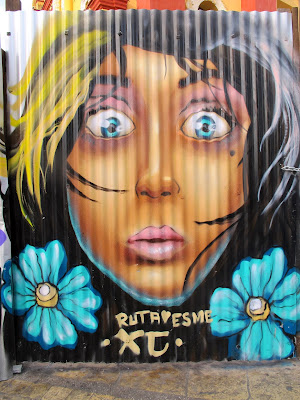Located in the historic center of San Cristobal de Las Casas is the Museo de Lost Altos de Chiapas Ex-Convento de Santo Domingo de Guzmán. The second floor is home to an amazing Maya textile collection from Chiapas, Mexico and Guatemala. There are three collections on display from the Formento Cultural Banamex collection (1990 - 2000), the Guatemala collection (1920-2000) and the Pellizzi collection (1950 - 1979).
The building dates back to the 17th century when the Dominicans occupied the convent until 1853. It later became a national heritage site.
It is a beautifully displayed museum with drawers under each garment that pull out to showcase other huipils or cloths from the region that the garment that is on display is from.
This particular drawer displayed a women's cloth (pano de mujer), 1930 - 1940, from Chichicastenango, Guatemala.
San Andres Larrainzar, Chiapas huipil from 1975.
A man's ceremonial cloth, 2012, from Venustiano Carranza, Chiapas, the only Tzotzil weaving community in the tropical lowlands.
Simply gorgeous!
A ceremonial napkin from San Antonio Aguas Calientes, Gautemala. 1950 - 1960.
A beautiful huipil from Chajul in Guatemala, around 1980 - 1990.
The Maya clothing has undergone changes over the years due to political, economic and religious factors. The dress for the women during the Classic period (A.D. 2000- 90) was a huipil (a handwoven short blouse or long dress) and an enreado (a wrap skirt made of hand-woven fabric. The configuration of the hand pleating at the waist varies from each region). The men wore a taparrabo (a loincloth) and a tilma (a cloak-like outer garment). It was not until the 16th century with the introduction of Catholicism the the dress changed, more of an emphasis that the whole body be covered, especially for the men. The introduction of silk and wool dramatically changed the weaving of the garments.
The 20th century brought major change with the use of industrial cotton thread available in countless colors and man-made fibers such as rayon which replaced silk and acrylic which replaced wool. There was certainly an explosion of color in the 1970's and 1980's.
Today there is a large movement to bring back the natural dyes and ancient designs.
A gorgeous combination of colors on this huipil from Comalapa, Guatemala.
A wedding Huipil, circa 1970, from Quetzaltenango, Guatemala.
Huipils from the Highlands in Chiapas, Mexico.
A huipil from San Juan El Bosque in Chiapas, 1975. El Bosque is the most northern village in the Highlands where cross-stitch embroidery was originated. Settled by refugees from San Juan Chamula after the Caste war of 1869. Due to the warmer climate in El Bosque, the woolen dress from San Juan Chamula was substituted to a blue cotton skirt and a wide, red vertical striped huipil.
Love the colors on this huipil with its ancient designs from Tenejapa, Chiapas. 1972.
A huipil from Comalapa, Guatemala / 1986. Such an interesting selection of colors.
A 1955 huipil from Magdalenas Aldama, Chiapas. Legion has it that is was Mary Magdalene who taught the women how to weave these elaborate brocaded fabrics at the beginning of the world. Many of the designs can be traced back to the Maya Classic period.
Pieces from San Juan Chamula (left) and Zinacantan (right).
Guatemala, 1980.
A wool huipil from San Juan Chamula, Chiapas / 1974. Prior to the Dominicans arrival, woven pelts of rabbit and cotton were worn to ward off the cold. The introduction of sheep's wool proved to be a far superior fabric. I have a natural wool hand-woven cape that I use as a throw and it is so beautifully, tightly woven. I can contest, is does keep you warm!
Huipil from Concepcion Chiquirichapa, Gautemala. 1980.
1990 - Huipil from Nebaj, Guatemala.
Zinacantan, Chiapas / 2015. A wedding garment, a hand-woven huipil with feathers spun into the thread in the lower border and in the pre-conquest-type rectangular design below the neck opening.
Textiles from Guatemala and Mexico
1. Shawl from Totonicapan, Guatemala / 1910 - 1920
2 and 3. See below
4. Skirt from San Juan Cotzal, Guatemala / 196- - 1970
5. Shawl from Totonicapan, Guatemala / 1980
6. Skirt from Chajul, Guatemala / 1940 - 1950
7. Cloth from Totonicapan, Guatemala / 1930
8. Belt from Zinacantan, Mexico / 2006
9. Cloth from Santa Maria de Jesus, Guatemala / 1940-1950
10. Skirt from San Pedro Sacatepequez, Guatemala / 1930 - 1940
11. Cloth from Santa Maria de Jesus, Guatemala / 1940
12. Skirt from San Pedro Sacatepequez, Guatemala / 1940 - 1950
13. Skirt from San Pedro Sacatepequez, Guatemala / 1960 - 1970
2. A Huipil, from Tactic, Guatemala / 1979.
Talk about a lively combination of color and design.
No. 3 - A skirt from Cuyotenanago, Guatemala / 1990
We visited the museo on the third day of my Magic of the Maya World tour that I lead just this month. A definite visit when you are in San Cristobal de Las Casas! I could have spent hours in the textile department.
Museo de Los Altos de Chiapas Ex-Convento de Santo Domingo de Guzmán
Avenida 20 de Noviembre s/n
San Cristobal de Las Casas, Chiapas, Mexico











































